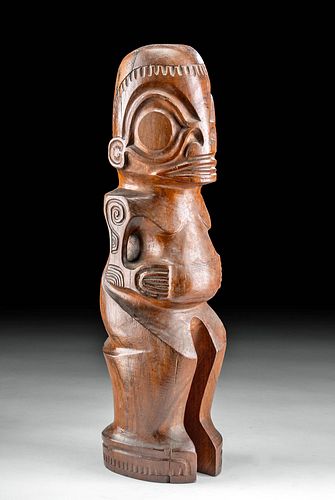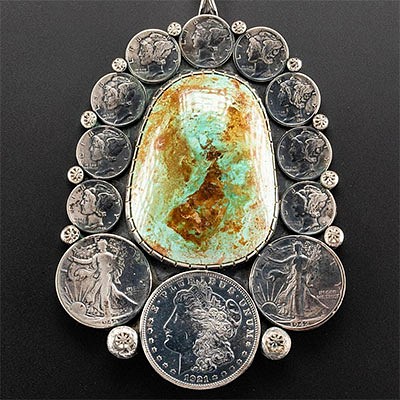20th C. Marquesas Islands Wooden Tiki Figure
Lot 120
About Seller
Artemis Gallery
686 S Taylor Ave, Ste 106
Louisville, CO 80027
United States
Selling antiquities, ancient and ethnographic art online since 1993, Artemis Gallery specializes in Classical Antiquities (Egyptian, Greek, Roman, Near Eastern), Asian, Pre-Columbian, African / Tribal / Oceanographic art. Our extensive inventory includes pottery, stone, metal, wood, glass and textil...Read more
Categories
Estimate:
$550 - $825
Absentee vs Live bid
Two ways to bid:
- Leave a max absentee bid and the platform will bid on your behalf up to your maximum bid during the live auction.
- Bid live during the auction and your bids will be submitted real-time to the auctioneer.
Bid Increments
| Price | Bid Increment |
|---|---|
| $0 | $25 |
| $300 | $50 |
| $1,000 | $100 |
| $2,000 | $250 |
| $5,000 | $500 |
| $10,000 | $1,000 |
| $20,000 | $2,500 |
| $50,000 | $5,000 |
| $100,000 | $10,000 |
| $200,000 | $20,000 |
About Auction
By Artemis Gallery
Feb 25, 2021
Set Reminder
2021-02-25 10:00:00
2021-02-25 10:00:00
America/New_York
Bidsquare
Bidsquare : American Frontier | Ethnographic | Tribal Art
https://www.bidsquare.com/auctions/artemis-gallery/american-frontier-ethnographic-tribal-art-6449
Featuring historical examples from the American, Spanish, and Mexican frontiers, as well as Native American, Ethnographic, Tribal, Oceanic, Spanish Colonial, more. All items offered for sale have been legally acquired, are legal to sell and are guaranteed to be as described or your money back. Artemis Gallery info@artemisgallery.com
Featuring historical examples from the American, Spanish, and Mexican frontiers, as well as Native American, Ethnographic, Tribal, Oceanic, Spanish Colonial, more. All items offered for sale have been legally acquired, are legal to sell and are guaranteed to be as described or your money back. Artemis Gallery info@artemisgallery.com
- Lot Description
Oceania, Marquesas Islands (French Polynesia), ca. 1940s CE. A fabulous wooden tiki sculpture of a figure with both hands placed on his bulbous belly. Naturally presenting a lovely woodgrain of sienna and caramel hues, the intriguing figure squats and gazes at its viewers through enormous, annular eyes with heavy lids over a wide nose and a broad mouth positioned slightly open to display its tongue. Looking very amphibious, the figure is nude, save for a striped headband that adorns his head. Embellished with decorative motifs of spiraling, curvilinear lines, his flat arms lay to his sides. The area between his legs is carved out, while each foot rests on its own half-circle-shaped plinth with incised tab designs along their peripheries. Size: 4.75" W x 16.5" H (12.1 cm x 41.9 cm)
Tiki figures originated in the Marquesas, and spread throughout most of Polynesia, often with local twists (for example, the moai of Easter Island are believed to be a form of tiki). They represent the ancestor Ti'i who is half human, half god and represents the first man. He is often shown with his hands on his stomach and his legs crouched, as here. His head is large to emphasize his power; his big eyes represent his great knowledge. Most tiki figures are carved from volcanic stone; wood examples are rarer. The island of Ua Huka is particularly famous for wooden carvings, most of which are made from miro (Oceania rosewood), tou (Oceania walnut), aito (iron wood), and the coconut tree. Tiki statues like this one were placed outside of houses, made to protect the inhabitants. In the southern Marquesas and Ua Huka (which is geographically closer to the north but culturally similar to the south), the term me'ae was used to describe a sacred place; these were often located just outside of villages and surrounded by palisades, with a house with protective, life-size wooden tiki located in the center. These buildings served as shrines for the village. A tiki like this one may have protected such a place in the past.
Provenance: private Newport Beach, California, USA collection
All items legal to buy/sell under U.S. Statute covering cultural patrimony Code 2600, CHAPTER 14, and are guaranteed to be as described or your money back.
A Certificate of Authenticity will accompany all winning bids.
We ship worldwide and handle all shipping in-house for your convenience.
#135655Collection label on base. Expected light scratches and abrasions to surface, commensurate with age. Otherwise, excellent and intact with nice earthen deposits.Condition
- Shipping Info
-
All shipping is handled in-house for your convenience. Your invoice from Artemis Gallery will include shipping calculation instructions. If in doubt, please inquire BEFORE bidding for estimated shipping costs for individual items.
-
- Buyer's Premium



 EUR
EUR CAD
CAD AUD
AUD GBP
GBP MXN
MXN HKD
HKD CNY
CNY MYR
MYR SEK
SEK SGD
SGD CHF
CHF THB
THB














